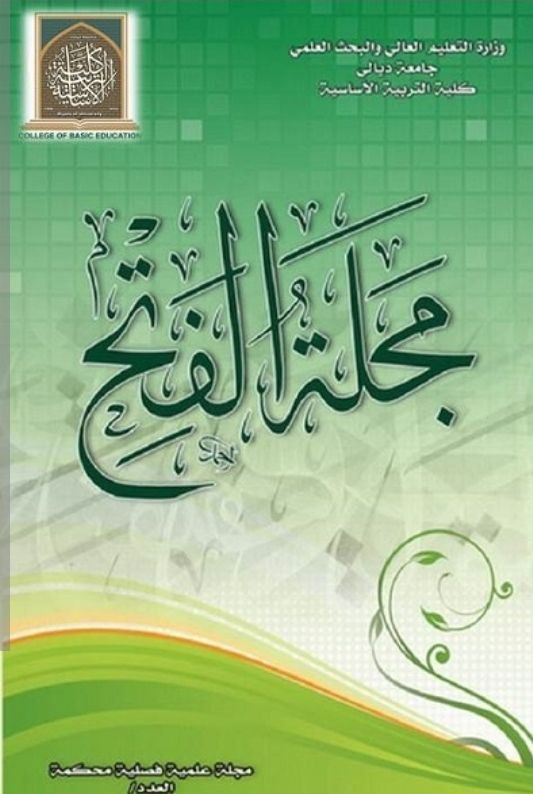The effect of using an aid in developing the scoring accuracy of the College of Arts football futsal team players
Abstract
The importance of the research is shown in the use of a new
assisting equipment to develop the accuracy of scoring of young
players. The research aimed at setting trainings by using assisting
equipment to develop the accuracy of scoring as well as knowing
the effect of these trainings by using the assisting equipment. The
researchers used the experimental method for it goes hand by hand
with the nature of the problem that is meant to be solved by
designing ( two equal groups, the experimental and the control for
the pre and post tests).
The sample of the research consists of (20) players from the
soccer team of the college of arts and the college of languages in
futsel. They were divided into two groups. The results has been
showed, analyzed, and discussed which showed that the
experimental group is ahead of the control group as far as the test's
results are concerned.
According to the results, the most important conclusions
proves that the assisting equipment has the effect in improving the
accuracy of scoring of the experimental group, and the trainings
used for improving the accuracy of scoring achieved a progress for
the experimental group in the post-test. Concerning the main
recommendations, the researchers urged the coaches to use the
assisting equipments in their training units in order to improve the
various skills in futsel, and the necessity of the coach to make the
players aware of the importance of scoring from the areas which
are in front of the opponent goal.
References
.إثشا٘١ ُػجذ سثٗ ٚؽج١ت أٌؼذٚٞ.االٔزمبء إٌفغٟ .رطج١مبد اٌزشث١خ اٌجذٔ١خ ٚاٌش٠بػ١خ
)أداسح ، رذس٠ت ، رؼٍ١ . )ُاٌمب٘شح : ِطجؼخ اٌؼّشأ١خ ،2002
.إعّبػ١ ًلبعُ عّ١ : ًرأص١ش رّش٠ٕبد خبطخ ثبعزخذاَ أعٙضح ٚأدٚاد ٌزطٛ٠ش عشػخ
أالعزغبثخ اٌؾشو١خ ٚدلخ إٌّبٌٚخ ٚاٌزٙذ٠ف ٌالػجٟ وشح اٌمذَ ٌٍظبالد ، أؽشٚؽخ دوزٛساٖ
، وٍ١خ اٌزشث١خ اٌش٠بػ١خ ، عبِؼخ ثغذاد ، 2012
.دٌٚذ ػجذاٌشؽّٓ:دساعخ أصش اعزخذاَ ثؼغ اٌٛعبئً اٌّغبػذح فٟ رؼٍُ اٌّٙبساد
األعبع١خ ٌٍؼجخ اٌزٕظ،سعبٌخ ِبعغز١ش،وٍ١خ اٌزشث١خ اٌش٠بػ١خ ٌٍجٕبد،عبِؼخ
األعىٕذس٠خ،1984
.فؼ١ٍخ ؽغ١ ٓ٠ٛعف: ِمبسٔخ ث١ ٓأصش ثؼغ اٌٛعبئً اٌزؼٍ١ّ١خ ػٍٝ رؼٍُ ِٙبسح اٌشمٍجخ
اٌغبٔج١خ ػٍٝ األسع، ِغٍخ اٌذساعبد ٚاٌجؾٛس، اٌّغٍذ اٌغبثغ، عبِؼخ ؽٍْٛ ، 1984
.فش٠ذ وبًِ: أعبع١بد اٌم١بط ٚاٌزمٛ٠ ُفٟ اٌزشث١خ، ؽ2، اٌىٛ٠ذ: ِىزجخ اٌفالػ ٌٍٕشش
ٚاٌزٛص٠غ ، 1998
.لبعُ ؽغٓ ؽغ١ :ٓاٌّٛعٛػخ اٌش٠بػ١خ ٚاٌجذٔ١خ اٌشبٍِخ فٟ األٌؼبة ٚاٌفؼبٌ١بد
ٚاٌؼٍَٛ اٌش٠بػ١خ ، ػّبْ، داس اٌفىش ٌٍطجبػخ ٚإٌشش ٚاٌزٛص٠غ، 1988
.وبظُ ػجبط ػجٛد : رأص١ش رّش٠ٕبد خبطخ ٚعٙبص ِمزشػ ٌزطٛ٠ش ثؼغ اٌمذساد
اٌجذٔ١خ ٚعشػخ ٚلٛح ٚدلخ اٌزظٛ٠ت ٌخّبعٟ اٌظبالد ثىشح اٌمذَ ٌفئخ إٌبشئ١ٓ
ثأػّبس)14 ـــ 16 عٕخ (،سعبٌخ ِبعغز١ش،وٍ١خ اٌزشث١خ اٌش٠بػ١خ، عبِؼخ ثغذاد ، 2013
.ػّبس صث١ش اؽّذ ٚ شبًِ وبًِ : اٌزىٕ١ه ٚاٌزىز١ه فٟ خّبعٟ وشح اٌمذَ ، ؽ1 ،
ثغذاد ، داس اٌىزت ٌٍٛصبئك ، 2005
ِ .غ١ذ ؽّ١ذ ِغ١ذ . رأص١ش ِٕٙظ رذس٠جٟ ِمزشػ فٟ رطٛ٠ش ثؼغ اٌظفبد اٌجذٔ١خ
اٌخبطخ ٌالػجبد خّبعٟ وشح اٌمذَ . سعبٌخ ِبعغز١ش ، وٍ١خ اٌزشث١خ اٌش٠بػ١خ ، عبِؼخ
اٌمبدع١خ ، 2007
ِ.ؾّذ طجؾٟ ؽغٕ١:ٓاٌم١بط ٚاٌزمٛ٠ ُفٟ اٌزشث١خ اٌجذٔ١خ اٌش٠بػ١خ، ط1،ؽ3،داس
اٌفىش اٌؼشثٟ،اٌمب٘شح 1995
ِ.شٚاْ ػجذ اٌّغ١ذ : اٌّٛعٛػخ اٌؼٍّ١خ ٌٍىشح اٌطبئشح، )ػّبْ ، ِؤعغخ أٌشاق
،
ِ.شٚاْ ػجذ اٌّغ١ذ:األعظ اٌؼٍّ١خ ٚاٌطشق اإلؽظبئ١خ ٌالخزجبساد ٚاٌم١بط فٟ
اٌزشث١خ اٌش٠بػ١خ . ؽ1 .ػّبْ: داس اٌفىش ٌٍطجبػخ ٚإٌشش ٚاٌزٛص٠غ ، 1999
ِ.ؾّذ ػجذ اٌغٕٟ ػضّبْ:اٌزؼٍُ اٌؾشوٟ ٚاٌزذس٠ت اٌش٠بػٟ،ؽ1،اٌىٛ٠ذ،داس
اٌمٍُ،1987
ِٚ .١غ شبًِ : رأص١ش رّش٠ٕبد خبطخ فٟ رطٛ٠ش ثؼغ اٌمذساد اٌجذٔ١خ ٚاٌّٙبساد
األعبع١خ ٚػاللزٙب ثذلخ اٌزٙذ٠ف ِٓ اٌضجبد ٚاٌؾشوخ ثىشح اٌمذَ ٌٍظبالد ، أؽشٚؽخ
دوزٛساٖ ، وٍ١خ اٌزشث١خ اٌش٠بػ١خ ، عبِؼخ ثغذاد ، 2012
٠ٛعف الصَ وّبػ : ثشٔبِظ ِمزشػ ٌزطٛ٠ش اٌّؼشفخ اٌخطط١خ ػٕذ الػجٟ وشح اٌمذَ ،
سعبٌخ ِبعغز١ش ، وٍ١خ اٌزشث١خ اٌش٠بػ١خ ، عبِؼخ اٌجظشح ، 1988
Downloads
Published
How to Cite
Issue
Section
License
Copyright (c) 2023 مجلة الفتح للبحوث النفسية والتربوية

This work is licensed under a Creative Commons Attribution 4.0 International License.
حقوق النشر والترخيص
تطبق مجلة الفتح للبحوث التربوية والنفسية ترخيص CC BY (ترخيص Creative Commons Attribution 4.0 International). يسمح هذا الترخيص للمؤلفين بالاحتفاظ بملكية حقوق الطبع والنشر لأوراقهم. لكن هذا الترخيص يسمح لأي مستخدم بتنزيل المقالة وطباعتها واستخراجها وإعادة استخدامها وأرشفتها وتوزيعها ، طالما تم منح الائتمان المناسب للمؤلفين ومصدر العمل. يضمن الترخيص أن المقالة ستكون متاحة على نطاق واسع بقدر الإمكان وأن المقالة يمكن تضمينها في أي أرشيف علمي.
لمزيد من المعلومات، يرجى متابعة الرابط: https://creativecommons.org/licenses/by/4.0/.



